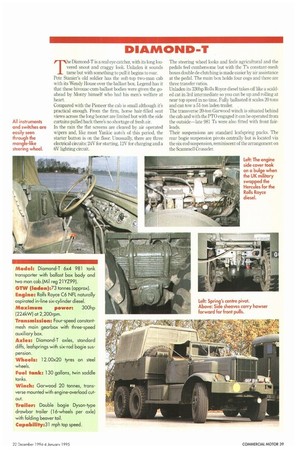DIAMOND -T T he Diamond-T is a real eye catcher, with its
Page 41

If you've noticed an error in this article please click here to report it so we can fix it.
long louvered snout and craggy look. Unladen it sounds tame but with something to pull it begins to roar. Pete Stanier's old soldier has the soft-top two-man cab with its Wendy House over the ballast box. Legend has it that these bivouac-cum-ballast bodies were given the goahead by Monty himself who had his men's welfare at heart.
Compared with the Pioneer the cab is small although it's practical enough. From the firm, horse hair-filled seat views across the long bonnet are limited but with the side curtains pulled back there's no shortage of fresh air.
In the rain the flat screens are cleared by air operated wipers and, like most Yankie auto's of this period, the starter button is on the floor. Unusually, there are three electrical circuits: 24V for starting, 12V for charging and a 611 lighting circuit.
The steering wheel looks and feels agricultural and the pedals feel cumbersome but with the T's constant-mesh boxes double de-clutching is made easier by air assistance at the pedal. The main box holds four cogs and there are three transfer ratios.
Unladen its 330hp Rolls Royce diesel takes off like a scalded cat in 3rd intermediate so you can be up and rolling at near top speed in no time. Fully ballasted it scales 20 tons and can tow a 51-ton laden trailer. .
The transverse 20-ton Garwood winch is situated behind the cab and with the PTO engaged it can be operated from the outside—late 981 Ts were also fitted with front fairleads.
Their suspensions are standard leafspring packs. The rear bogie suspension pivots centrally but is located via the six-rod suspension, reminiscent of the arrangement on the Scammell Crusader.




















































































































